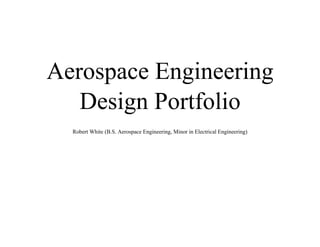This document summarizes Robert White's qualifications for an aerospace engineering position. It includes his education background with a B.S. in Aerospace Engineering and minor in Electrical Engineering from Purdue University. It outlines relevant skills and work experience, including internships modifying balloon and robot camera systems. It also details involvement in student engineering projects including a bucket elevator excavator for a lunar mining robot and cargo lander designs for a moon base project.

![US Citizen
32 Sunrise Ave, 973-557-0371
Bloomingdale NJ, 07403 White261@purdue.edu
Education
Purdue University [Fall 2012 – Spring 2016]
Bachelor of Science in Aeronautical & Astronautical Engineering
Minor in Electrical Engineering
GPA: 3.42/4.00
Skills
Programming Languages: C++, Matlab, LabView, Python 2 and 3, ROS (Robotic Operating System)
CAD, CAM, FEA and Manufacturing: CATIA, ANSYS FEA, SolidWorks, GIBBS, G-code, CNC lathe and milling machines, FEMM (Finite Element Method Magnetics)
Electronics Hardware: Arduino, Rabbit Core Module
Other: Open Water Dive Certification, New Jersey Boating Certification, Interest in pursuing Sky Diving License
Work Experience
Millennium Space Systems (El Segundo, CA) [Intern Summer 2015]
Modified a 6 DOF balloon platform to simulate satellite movement and increased carrying capacity and structural stiffness.
Integrated ROS framework across multiple computers to control balloon.
Installed Infrared Motion Capture System (MOCAP) and integrated into ROS.
Built and programmed laser mounted gimbal controlled though ROS to track objects in (MOCAP) volume.
Telemetrics Inc. (Mahwah, NJ) [Intern Summer 2014]
Redesigned components to eliminate 2 hours of installation time on a robot camera trolley.
Led Intern project to create green screen tracking program, focused on tracking algorithm and mechanical design of system.
Redesigned and modified components during production when critical parts from suppliers were manufactured incorrectly.
Tech Products Inc. (Midland Park, NJ) [Part Time 2008 – 2011]
Operating CNC Milling and lathe equipment, CAM using GIBBS, product assembly and testing.](https://image.slidesharecdn.com/9ab6e3c7-8383-4ece-b64a-2342a4324de3-160804144439/85/Robert-White-Portfolio-2-320.jpg)




